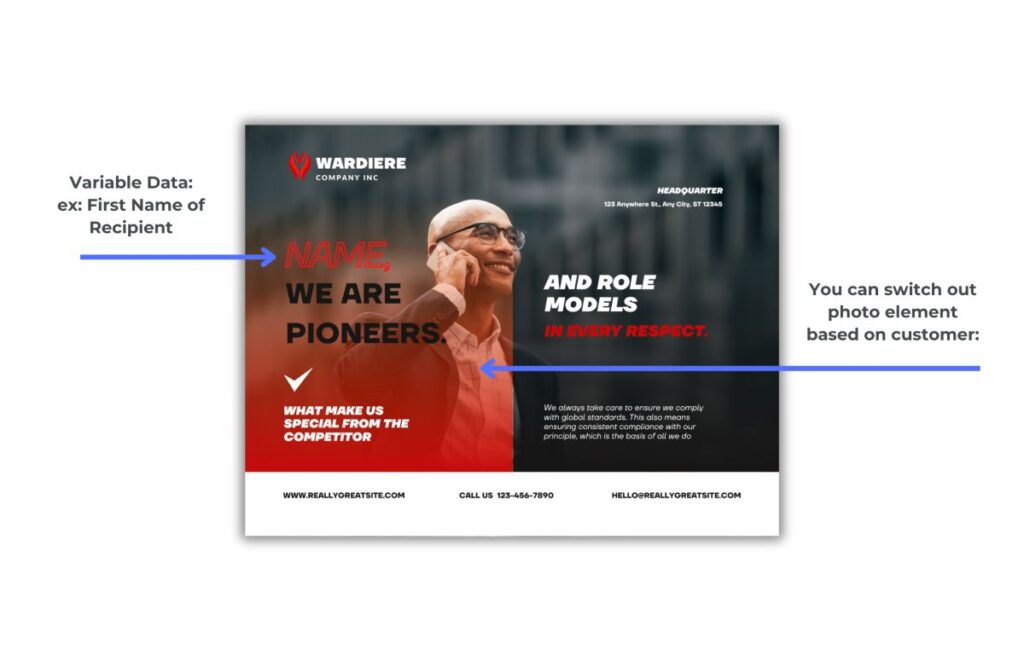In the fast-paced world of B2C marketing, staying at the forefront of innovation is key to delivering impactful and personalized marketing materials to customers.
As we step into February of 2024, we’re excited to unveil the untapped potential of Variable Data Printing (VDP) and how it can revolutionize your print marketing strategy.
Variable Data Printing has become a powerful tool in a brand’s marketing arsenal, allowing businesses to create personalized and impactful communication materials that resonate with their audience on an individual level.
In this blog post, we will discuss how leveraging customer data effectively through Variable Data Printing can allow marketers to create more relevant, engaging, and ultimately successful interactions with their customers. The end goal? Fostering long-term loyalty and brand advocacy!
Understanding Variable Data Printing (VDP)
Variable Data Printing is not just a technological advancement; it’s a game-changer for brands looking to create highly personalized and targeted print materials. Unlike traditional printing, VDP allows for the customization of text, images, and other elements on a per-piece basis using digital printing technology.
The process involves merging digital printing technology with data-driven customization to create personalized and targeted content. This means you can tailor your prints to speak directly to each individual recipient, elevating engagement and response rates.
According to Linkedin Article, The Impact of Variable Data Printing: Driving Personalized Marketing Success, “The variable data printing market in labels is projected to grow from USD 10.79 Billion in 2016 to USD 22.27 Billion by upcoming years, at a CAGR of 15.61%.”

Here’s how Variable Data Printing works:
- Data Integration:
- The process starts with collecting and integrating relevant customer data. This data can include information about the customer such as name, address, preferences, purchase history, or any other variable data that is pertinent to your specific campaign.
- Design Template:
- A design template is created, incorporating placeholders for the variable data elements. These placeholders are points in the design where personalized content will be inserted based on the recipient’s information.
- Digital Printing Technology:
- Unlike traditional printing methods that use printing plates, VDP relies on digital printing technology. Digital presses can print variable information without manual plate changes, making the process more flexible and efficient.
Solo Printing maintains an impressive digital printing department. We’ve invested in the industry leading Dry Ink technology with our Xerox® 1000i digital press. It uses no fuser oil, giving all your applications a smooth, offset-like finish. It also maintains Advanced Xerox® color management technology, with closed-loop process controls, enables vivid, consistent color rendition from page to page and job to job every single time. Because our digital press always prints at high-resolution standards, it delivers amazing mid-tones, crisp text, pure neutrals, detailed shadows, bright highlights and excellent photo rendering, resulting in an outstanding image quality. Learn more about our digital printing services here.
- Data Mapping:
- The variable data is mapped to the corresponding placeholders in the design template. This mapping is crucial to ensure that the right information is placed in the right location within each printed piece.
- Printing in Batches:
- VDP allows for the printing of multiple variations in a single print run. Each piece can have unique content while maintaining the overall design and layout. This is particularly beneficial for personalized marketing campaigns with large audience segments.
- Real-Time Printing:
- Variable Data Printing operates in real-time, meaning that the printing press can seamlessly transition from one set of personalized content to another without interruptions. This efficiency is a key advantage over traditional printing methods.
- Quality Control:
- Quality control measures are implemented to ensure accuracy and consistency. Automated systems often check for errors, ensuring that the variable data is correctly merged with the design template and that there are no printing issues.
- Finishing Processes:
- After printing, the personalized materials go through finishing processes such as cutting, binding, or other relevant procedures. Despite the variable data, the finishing processes are standardized to maintain overall print quality.
- Distribution:
- Once printed and finished, the personalized materials are ready for distribution. Whether it’s direct mail, promotional materials, or other print collateral, personalized content enhances the relevance and impact of the printed pieces.
Solo Printing both prints and distributes for Fortune 1000 companies around the nation. As state-of-the-art printers, we specialize in full-service print production for our customers. We would love to work with you on your next print project, request a quote today at: www.soloprinting.com/request-a-quote.
Why Customer Data Matters
Customer data plays a pivotal role in personalized marketing, serving as the foundation for creating targeted and tailored experiences for individual customers.

In the 1970s, a pivotal shift occurred in the landscape of direct marketing as marketers recognized the need to understand their customers on a more nuanced level. This era marked the emergence of a strategy where detailed customer profiles became the cornerstone of targeted campaigns. Instead of relying solely on broad demographic data, marketers sought to gather more intricate information about their audience.
The practice of building customer profiles extended beyond demographics and subscription data. Marketers delved into a comprehensive collection of data points, including purchase history, preferences, and even behavioral data. Behavioral insights, such as the frequency of purchases and responses to previous campaigns, provided a deeper understanding of customer interactions. This holistic approach allowed marketers to refine their targeting strategy, ensuring that each campaign was not only personalized but also aligned with the evolving behaviors of their customer base. Ultimately, this historical practice laid the foundation for the data-driven, personalized marketing strategies that continue to thrive in today’s dynamic marketing landscape.
The goal is that with the collection of data, , marketers could craft messages and promotions that spoke directly to the unique preferences of each customer. This shift towards personalized campaigns proved to be immensely successful, yielding fantastic results for those who embraced this strategy.
Here are key reasons why customer data is crucial in the context of personalized marketing:
Understanding Customer Behavior:
- Insights into Preferences:
- Customer data provides valuable insights into customer preferences, behaviors, and purchasing patterns. Understanding what products or content a customer engages with enables marketers to create personalized recommendations and offers.
- Segmentation and Targeting:
- Customer data allows for effective segmentation based on various criteria such as demographics, location, and past interactions. By categorizing customers into segments, marketers can deliver content and promotions that are highly relevant to each group.
- Personalized Content Creation:
- With detailed customer data, marketers can craft personalized messages that resonate with individual interests. This goes beyond just addressing customers by name; it involves creating content that aligns with their preferences, ensuring a more meaningful and engaging experience.
- Improved Customer Engagement:
- Personalized marketing ensures that every customer interaction is relevant and timely. By leveraging data, marketers can send messages and offers at the right moments, increasing the likelihood of customer engagement and conversion.
- Enhanced Customer Relationships:
- Personalized experiences based on accurate customer data contribute to building trust. When customers feel understood and catered to, it strengthens the relationship between the brand and the customer.
- Dynamic Customer Journey:
- Customer data helps map the customer journey, allowing marketers to adapt their strategies at each touchpoint. Understanding where a customer is in their journey enables the delivery of content that meets their specific needs at that stage.
- Optimizing Marketing ROI:
- Personalized marketing, fueled by customer data, allows for more efficient resource allocation. Instead of deploying generic campaigns to a broad audience, resources can be focused on targeted efforts, optimizing return on investment (ROI).
- Agile Marketing Strategies:
- Customer data enables marketers to adapt quickly to changes in customer behavior and market trends. This ability is crucial in a dynamic business environment where customer preferences can evolve rapidly.
- Data-Driven Decision-Making:
- Marketers can make data-driven decisions when armed with comprehensive customer data. This ensures that strategies are not based on assumptions but on real insights derived from customer interactions and behaviors.
- Compliance and Privacy:
- As personalized marketing relies on customer data, it is essential to prioritize data privacy and compliance with regulations. Respecting customer preferences and ensuring data security build trust and maintain a positive brand image.
What does Variable Data Printing offer to companies?
One significant advantage is personalization, allowing the customization of content for each recipient, thereby making printed materials more relevant and engaging. This approach extends to targeted marketing, where messages can be tailored to specific segments based on individual preferences or behaviors, fostering more meaningful connections with the audience. The efficiency and flexibility offered by variable data printing are notable, efficiently handling large print runs with varying content and providing companies with the flexibility to adapt their marketing approaches.
Ultimately, the incorporation of personalized and relevant content through variable data printing tends to yield improved response rates, creating a more impactful and effective marketing campaign compared to generic materials.

- Enhanced Engagement:
- Tailors prints to speak directly to individual recipients, fostering higher engagement.
- Moves beyond generic printing methods to deliver personalized content.
- Dynamic Content Customization:
- VDP goes beyond static prints by allowing dynamic content customization on an individual basis.
- Elements like text, images, and even promotional offers can be tailored for each recipient.
- This dynamic approach ensures that every piece is unique, capturing the attention of recipients effectively.
- Emerging Technologies in VDP:
- Advances in VDP technologies include more sophisticated algorithms for data analysis.
- Artificial Intelligence (AI) is increasingly being integrated to predict and personalize content based on user behavior.
- Augmented Reality (AR) and QR code integration offer interactive and immersive experiences in printed materials.

The Power of Personalization
In an era where consumers are inundated with generic marketing messages, personalized communication stands out. VDP enables you to go beyond simply addressing your audience by their names. Dive deep into customer data to personalize content based on preferences, purchase history, or geographic location. The result? Print materials that resonate on a personal level.
- Deep Customer Insight:
- Dive into customer data to personalize content based on preferences, purchase history, and geographic location.
- Result: Print materials resonate on a personal level, strengthening the brand-consumer connection.
- Beyond Name Personalization:
- Personalization extends beyond addressing individuals by name; it delves into lifestyle preferences, behaviors, and interactions.
- Utilizing machine learning algorithms helps in predicting personalized content that aligns with individual preferences.
- Geotargeting for Localization:
- Geographic information can be harnessed to customize content based on the location of the recipient.
- Localized offers, event promotions, or even region-specific imagery enhance the relevance of printed materials.
Targeted Campaigns for Enhanced ROI
Say goodbye to one-size-fits-all marketing campaigns. With VDP, you can create highly targeted and relevant campaigns that speak directly to specific segments of your audience. Whether you’re promoting a product launch, special offer, or event, VDP allows you to craft messages that resonate with the unique interests and needs of each recipient.
- Boosted Engagement:
- Significantly enhances the return on investment (ROI) for marketing efforts.
- Delivers personalized messages that align with the unique interests and needs of each recipient.
- Behavioral Triggers in VDP:
- Utilize behavioral triggers to automate the customization process based on user interactions.
- Triggered campaigns, such as personalized follow-ups after a website visit, enhance the timeliness and relevance of the message.
- Combining VDP with Multichannel Marketing:
- Integrate VDP seamlessly with digital channels for a holistic marketing approach.
- Create consistent messaging across print and online platforms, reinforcing the impact of personalized campaigns.
- You can do this with Solo Printing’s direct mail digital integration service, SP Direct.
- Learn here how: https://soloprinting.com/services/direct-mail-digital-integration/

Integrating VDP into Your Marketing Mix
Unleashing the power of VDP requires a strategic approach. Collaborate with your marketing team to identify key touchpoints in your customer journey where personalized print materials can make a significant impact. From direct mail campaigns to event promotions, VDP can be seamlessly integrated into various marketing channels.
Strategic Approach:
- Identify key touchpoints in the customer journey for personalized print materials.
Versatile Integration:
- Seamlessly integrate VDP into various marketing channels, including:
- Direct mail campaigns
- Omnichannel Marketing
- Event promotions
- Customer onboarding materials
Data Security Measures:
- Address concerns related to data security by implementing robust measures in VDP processes.
- Encryption, secure data transfer protocols, and compliance with data protection regulations are critical considerations.
Continuous Testing and Optimization:
- Implement a culture of continuous testing and optimization to refine and improve personalized content.
- A/B testing various elements ensures that the chosen personalization strategies resonate effectively with the target audience.

As we embrace the possibilities of Variable Data Printing in February 2024, let Solo Printing guide you in unlocking the full potential of personalized print marketing. Connect with us today to explore how VDP can elevate your brand and drive tangible results.
Elevate your marketing strategy with Solo Printing as your trusted partner in VDP excellence. Consult with Solo Printing to unlock the full potential of personalized print marketing.
Solo Printing offers customized solutions tailored to your specific marketing goals. Work closely with their experienced team to develop personalized print materials that align with your brand identity and campaign objectives.
Maximize impact. Personalize with precision. Thrive with Solo Printing.



